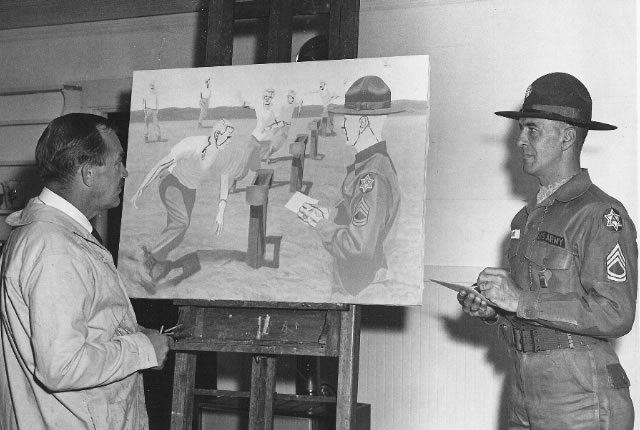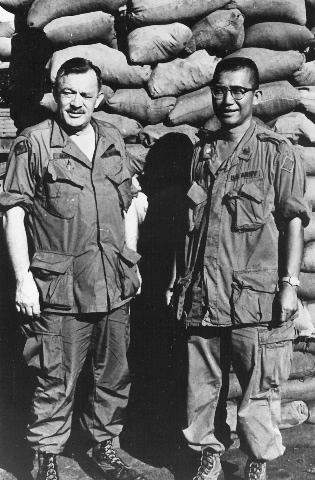

From Civilian to Soldier During the Vietnam Years
A Soldier's Experiences Documented and Recorded in Fine Art
A memorial to the young men of America who fought in
the war in Vietnam.
The individuals, their training, their experiences, relating to the
Vietnamese people,
and more, are done in oils, graphite, ink, casein, aquarelle and pastels.
The following 30 artworks were created by Phillip G. Schuyler
in the methods of the old masters using modern materials.
A story that begins with "The First Day" and ends
with, "Death of a Soldier".
No stranger to combat, Philip Schuyler was wounded twice in World War II,
then contracted Polio from swamps in France. He was Eventually
flown home on a litter and spent years in hospitals.
Mr. Schuyler's first motivation in recording
experiences of the men and women sent
to serve their country was to express appreciation to them in his own
unique way.
Closely following that was his concern for the loved ones they were
leaving behind.
The first dozen major artworks were, therefore, accompanied by plaques
documenting
names, units, dates, locations and activities portrayed in
each work of art. These
were intended to help the families understand the new lives of their
family members
in the unfamiliar world of the military. With consideration for historical
significance,
the plaques are reproduced here exactly as written at the time the
artworks were created.
The first twelve artworks are oil on canvas or
Masonite.
Eighteen smaller works are done in various media.
 |
 |
 |
 |
 |
| The First Day 30" x 40" Oil on Masonite |
Physical
Fitness 40" x 30" Oil on Canvas |
Rifle Practice 30" x 24" Oil on Canvas |
His First Patch 46" x 36" Oil on Canvas |
Graduation 48" x 40" Oil on Canvas |
 |
 |
 |
 |
 |
| Div. Sgt. Major 18" x 22" Oil on Canvas |
West Point 32" x 40" Oil on Canvas |
Attack 40" x 30" Oil on Canvas |
The Search 40" x 30" Oil on Canvas |
Chaplains 45.5" x 39" Oil on Canvas |
 |
 |
| Diplomats 24" x 32" Oil on Canvas |
Death of a
Soldier 30" x 40" Oil on Canvas |


Away from combat,
Americans often gave kind responses to needs of Vietnamese civilians.
Building swings and playing games with children, medics caring for
health
and medical needs, and other such responses benefited both
the civilians and the Americans.
Traveling in the Northwest in 1965, artist
Philip Schuyler discovered that the
Army's Fourth Division was headquartered at Fort Lewis, Washington.
He had been a
lieutenant in the Fourth Division during the invasion of France in 1944
and had served
until he was rendered disabled and sent home.
In a wave of nostalgia he went to visit the Fourth Division at Fort Lewis
and discovered
it was preparing for commitment to action. Still unfit for active duty but
having been a
professional artist for many years, he went to the division's commander,
General Collins,
with a proposal. "I can't lead them but I will memorialize them in art."
General Collins was pleased.
Mr. Schuyler took up residence at the Fort
Lewis Inn and began the first painting.
Much publicity followed. The first painting was exhibited. Then the
first three were shown.
Jose Nunez, curator of the Washington, D.C. Gallery of Art, declared the
works
"modern masterpieces." The painting "Chaplains" was the Picture of Honor
at an exhibition of religious art in California.

When eleven paintings were completed they
were exhibited at West Point.
The Teamster's Union asked to buy the eleven for $250,000 to exhibit
throughout the nation. Mr. Schuyler would not sell.
He was not finished with the story.
In 1967, with scenes of induction into the military and training completed
Mr. Schuyler sought permission to visit the troops in Vietnam to continue
their story.
He was given the designation of Historian.
His wife was given permission to accompany him as a journalist.
She would continue documentation and written descriptions
of the scenes to inform families at home.
At the last minute, with preparations made and immunizations completed,
permission for a female journalist was denied.
The artist and veteran alone would be able to go to places too difficult
and risky
for a woman so she waited at home like thousands of other women.
Mr. Schuyler collected sketches, snapshots, data, and samples of many
kinds
for reference materials to be used in the artworks later.
In the Highlands of Vietnam, near the Laotian border, he visited a special
friend,
Chaplain Howard T. Lee. They are shown in a picture below,
standing in front of the Chaplain's sand-bagged hut.

Many stops and visits later, after collecting
much more reference material
and information, Mr. Schuyler returned home to continue the story of
our young men in Vietnam. The series had now grown to 30 pieces of art
portraying their activities.

During the years that followed, Mr. Schuyler
built
a Fine Arts Department at the University of Santa Clara.
After several years his health began to fail. He died in 1981.
Following his death the collection languished in storage for many years.
He had never seen his entire series exhibited together.
Now, with the modern technology of the Internet, it has become possible
to provide a virtual gallery for the display of these artworks.
At Last, Mr. Schuyler's dream is fulfilled - though in a way he would
have never envisioned. They can now be visited in the modern day
Museum of the Internet, on this web site, at any time.

For Information Contact: schuylersart@gmail.com
Copyright © 2005 Schuyler Editions, All Rights Reserved